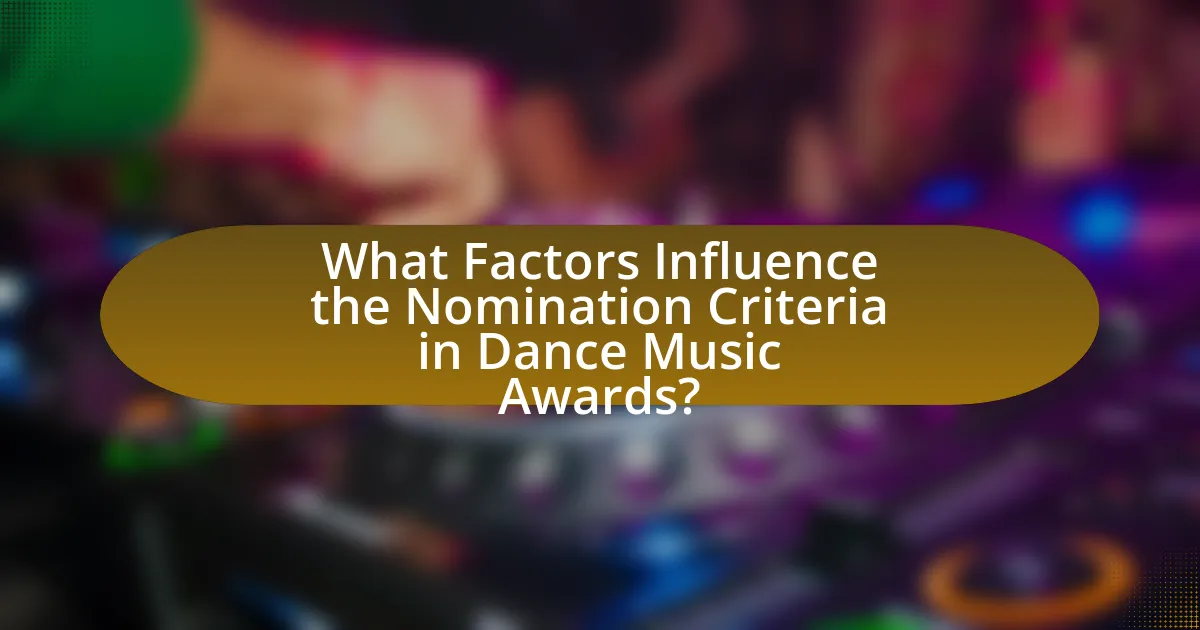The article focuses on the criteria for nominations in Dance Music Awards, highlighting key factors such as artistic merit, popularity, and industry impact. It explains how nominations are determined through a combination of industry votes, public votes, and expert panels, ensuring a balance between professional recognition and public sentiment. The article also outlines specific nomination categories, the influence of voting processes, and the importance of transparency and fairness in the nomination process. Additionally, it discusses how evolving music trends and artist achievements impact nomination eligibility, while addressing challenges and controversies faced by awards in establishing criteria.

What are the Criteria for Nominations in Dance Music Awards?
The criteria for nominations in Dance Music Awards typically include artistic merit, popularity, and industry impact. Artistic merit evaluates the creativity and quality of the music produced, while popularity is often measured through sales, streaming numbers, and fan engagement. Industry impact assesses how the artist or track has influenced the dance music scene, including contributions to trends and collaborations. These criteria ensure that nominations reflect both the artistic and commercial success within the dance music genre.
How are nominations determined in the dance music industry?
Nominations in the dance music industry are determined primarily by a combination of industry votes, public votes, and expert panels. Industry professionals, including producers, DJs, and record labels, typically contribute to the nomination process through voting mechanisms established by award organizations. For example, the International Dance Music Awards (IDMAs) utilize a voting system where both industry insiders and fans can nominate their favorite artists and tracks. This dual approach ensures that nominations reflect both professional recognition and public popularity, thereby enhancing the credibility and relevance of the awards.
What specific categories exist for nominations in dance music awards?
Dance music awards typically feature categories such as Best Dance Album, Best Dance Track, Best DJ, Best Live Act, Best Producer, and Best New Artist. These categories are designed to recognize excellence in various aspects of dance music, including production quality, performance, and overall contribution to the genre. For instance, the International Dance Music Awards (IDMAs) include similar categories, reflecting industry standards and trends in dance music recognition.
How do voting processes influence nomination outcomes?
Voting processes significantly influence nomination outcomes by determining which candidates receive recognition based on voter preferences and participation. In dance music awards, the structure of voting—whether it is public, industry-based, or a combination—directly impacts which artists or tracks are nominated. For instance, public voting can amplify popular trends, as seen in the 2020 DJ Mag Top 100 DJs poll, where fan engagement led to the rise of emerging artists. Conversely, industry voting may prioritize established names, reflecting professional opinions over public sentiment. This duality illustrates how the mechanics of voting shape the landscape of nominations, ultimately affecting which artists gain visibility and accolades in the dance music scene.
Why is transparency important in the nomination process?
Transparency is important in the nomination process because it fosters trust and credibility among stakeholders. When the nomination criteria and procedures are clear, participants can understand how decisions are made, which reduces the likelihood of perceived bias or favoritism. For instance, a study by the International Journal of Arts Management highlights that transparent processes in award nominations lead to higher participant satisfaction and engagement, as individuals feel their contributions are recognized fairly. This trust is essential for maintaining the integrity of the awards and encouraging broader participation in the dance music community.
What measures are taken to ensure fairness in nominations?
To ensure fairness in nominations for Dance Music Awards, a transparent and standardized nomination process is implemented. This process typically includes criteria such as eligibility requirements, a diverse panel of judges, and public voting mechanisms. For instance, eligibility criteria often specify that nominees must have released music within a certain timeframe, ensuring that all nominations are relevant and current. Additionally, a diverse panel of judges, representing various backgrounds and expertise in the dance music industry, helps to mitigate bias and promote inclusivity. Public voting may also be incorporated, allowing fans to participate in the nomination process, which further enhances transparency and fairness. These measures collectively aim to create an equitable environment for all potential nominees.
How do industry standards affect nomination criteria?
Industry standards significantly shape nomination criteria by establishing benchmarks for quality, innovation, and relevance within the dance music sector. These standards often dictate the technical and artistic elements that nominees must meet, ensuring that only those who adhere to recognized practices are considered. For instance, adherence to sound engineering standards and production quality is crucial, as evidenced by the Grammy Awards, which require nominees to demonstrate excellence in these areas. Consequently, industry standards serve as a framework that not only influences the selection process but also elevates the overall quality of submissions, aligning them with the expectations of both industry professionals and audiences.

What Factors Influence the Nomination Criteria in Dance Music Awards?
The factors that influence the nomination criteria in Dance Music Awards include artistic merit, popularity, innovation, and industry impact. Artistic merit assesses the quality and creativity of the music, while popularity is measured through sales, streaming numbers, and audience engagement. Innovation evaluates how the work pushes boundaries within the genre, and industry impact considers the artist’s influence on peers and the broader music landscape. These criteria are often shaped by voting bodies, industry professionals, and public opinion, ensuring a comprehensive evaluation of nominees.
How do artist achievements impact their nomination eligibility?
Artist achievements significantly influence their nomination eligibility by establishing a track record of success and recognition within the industry. Achievements such as chart performance, sales figures, and critical acclaim demonstrate an artist’s impact and popularity, which are often key criteria for nominations. For instance, awards like the Grammy Awards consider an artist’s previous accolades and contributions to the music landscape when determining eligibility. This is evident as artists with multiple hit singles or albums that have received industry awards are more likely to be nominated, reflecting their established reputation and influence in the dance music genre.
What role do sales and streaming numbers play in nominations?
Sales and streaming numbers significantly influence nominations in Dance Music Awards by serving as key indicators of an artist’s popularity and commercial success. High sales figures and substantial streaming counts demonstrate audience engagement and market impact, which are critical factors considered by voting bodies. For instance, in 2022, tracks that topped the Billboard Dance/Electronic charts often received nominations, reflecting the correlation between commercial performance and recognition in awards. This trend underscores the importance of quantifiable metrics in the nomination process, as they provide a tangible measure of an artist’s reach and influence within the dance music genre.
How is artistic innovation considered in the nomination process?
Artistic innovation is a critical factor in the nomination process for Dance Music Awards, as it evaluates the originality and creativity of the work submitted. Nominators assess how new ideas, techniques, and styles are integrated into the music, which can significantly influence the overall impact and reception of the piece. For instance, innovative use of technology or unique collaborations can set a nominee apart, demonstrating a forward-thinking approach that resonates with contemporary audiences. This emphasis on innovation aligns with industry trends, where fresh and groundbreaking contributions are increasingly valued, reflecting the dynamic nature of dance music.
What is the significance of public opinion in nominations?
Public opinion plays a crucial role in nominations for dance music awards as it directly influences the selection process and the perceived legitimacy of nominees. When the public expresses strong preferences for certain artists or tracks, award committees often take these sentiments into account to ensure that nominations reflect popular taste and trends. For instance, awards like the Grammy Awards and the Billboard Music Awards consider fan voting and streaming data, which are indicators of public opinion, to determine nominees. This integration of public sentiment not only enhances the relevance of the awards but also fosters greater engagement from the audience, as they feel their voices contribute to the recognition of their favorite artists.
How do fan votes contribute to the nomination criteria?
Fan votes significantly influence the nomination criteria by allowing the audience to directly participate in the selection process. This engagement ensures that popular artists and tracks, as determined by listener preferences, are recognized in the nominations. For instance, in various dance music awards, fan voting often accounts for a substantial percentage of the total votes, thereby shaping the final list of nominees based on public support. This method not only democratizes the nomination process but also reflects current trends and tastes within the dance music community, making the awards more relevant and representative of the audience’s interests.
What platforms are used to gauge public sentiment for nominations?
Social media platforms, online polls, and music streaming services are commonly used to gauge public sentiment for nominations in dance music awards. Social media platforms like Twitter and Instagram allow fans to express their opinions and engage in discussions about nominees. Online polls provide a structured way for audiences to vote on their favorite artists or tracks, while music streaming services often analyze listener data and trends to reflect public preferences. These platforms collectively contribute to understanding audience sentiment and influence nomination decisions.

How Do Different Dance Music Awards Approach Nominations?
Different dance music awards approach nominations through various criteria, including genre specificity, public voting, and industry expert panels. For instance, the DJ Awards focus on specific genres like house and techno, allowing fans to vote for their favorite artists, while the International Dance Music Awards utilize a combination of public votes and industry expert nominations to ensure a balanced representation. Additionally, the Electronic Music Awards emphasize innovation and impact within the electronic music scene, often considering factors such as social media presence and streaming statistics. These diverse methodologies reflect the awards’ goals to recognize excellence in dance music while engaging both fans and industry professionals.
What are the unique nomination criteria for major dance music awards?
Major dance music awards typically have unique nomination criteria that include artistic merit, commercial success, and industry impact. Artistic merit evaluates the creativity and originality of the music, while commercial success is measured through sales figures, streaming numbers, and chart positions. Industry impact considers the influence of the artist or track on the dance music scene, including contributions to genre evolution and cultural significance. For example, the Grammy Awards and the International Dance Music Awards utilize these criteria to ensure that nominees reflect both artistic excellence and popularity within the dance music community.
How do regional awards differ from international awards in their criteria?
Regional awards typically focus on local talent, cultural relevance, and community impact, while international awards emphasize global recognition, broader industry standards, and cross-border appeal. For instance, regional awards may prioritize artists who have made significant contributions to their local music scene, reflecting the tastes and preferences of that specific area. In contrast, international awards often require nominees to meet criteria that resonate with a wider audience, such as chart performance, international collaborations, and global sales figures. This distinction is evident in awards like the Grammy Awards, which consider worldwide influence, compared to local awards that celebrate regional achievements and styles.
What are the commonalities across various dance music awards in terms of nominations?
Commonalities across various dance music awards in terms of nominations include the recognition of outstanding artists, tracks, and albums within specific categories such as Best DJ, Best Track, and Best Album. These awards typically evaluate nominees based on criteria like popularity, critical acclaim, and innovation in the genre. For instance, awards like the DJ Mag Top 100 and the International Dance Music Awards both consider public voting and industry expert opinions to determine nominees, ensuring a blend of fan engagement and professional recognition. Additionally, many awards emphasize the importance of genre diversity, nominating artists from sub-genres like house, techno, and trance, reflecting the broad spectrum of dance music.
What challenges do awards face in establishing nomination criteria?
Awards face significant challenges in establishing nomination criteria due to the need for inclusivity and fairness while maintaining industry standards. Balancing diverse artistic expressions within dance music genres complicates the creation of criteria that accurately reflect the breadth of talent. Additionally, subjective interpretations of quality and innovation can lead to disagreements among stakeholders, including artists, critics, and fans. For instance, the Dance Music Awards must consider varying opinions on what constitutes excellence, which can result in inconsistent criteria that may alienate certain groups. Furthermore, the evolving nature of dance music trends necessitates regular updates to criteria, making it difficult to establish a stable framework that remains relevant over time.
How do evolving music trends affect nomination standards?
Evolving music trends significantly influence nomination standards by shifting the criteria that award bodies use to evaluate artists and their work. As genres blend and new styles emerge, such as the rise of electronic dance music and its fusion with pop, nomination standards adapt to recognize innovative sounds and diverse influences. For instance, the inclusion of sub-genres like future bass and trap in major awards reflects this shift, as seen in the Grammy Awards expanding categories to accommodate these trends. This evolution ensures that nominations remain relevant and representative of the current musical landscape, thereby encouraging artists to innovate and experiment within their craft.
What controversies have arisen regarding nomination processes in the past?
Controversies regarding nomination processes in dance music awards have often centered on perceived biases and lack of transparency. For instance, allegations have emerged that certain artists or genres receive preferential treatment, leading to claims of unfairness among nominees. In 2019, the Electronic Music Awards faced criticism when several prominent DJs were excluded from nominations, prompting discussions about the criteria used for selection. Additionally, the influence of industry insiders and marketing strategies has raised questions about the authenticity of nominations, as seen in the backlash against the Grammy Awards for overlooking electronic music categories in favor of mainstream artists. These instances highlight ongoing debates about equity and representation in the nomination processes of dance music awards.
What Best Practices Can Artists Follow to Enhance Their Chances of Nomination?
Artists can enhance their chances of nomination for dance music awards by consistently producing high-quality music, engaging with their audience, and maintaining a strong online presence. High-quality music is essential as it showcases artistic talent and creativity, which are critical criteria for nominations. Engaging with the audience through social media and live performances fosters a loyal fan base, increasing visibility and support during the nomination process. Additionally, a strong online presence, including a well-maintained website and active participation on music platforms, helps artists reach a broader audience and industry professionals, thereby improving their chances of being recognized for nominations.
